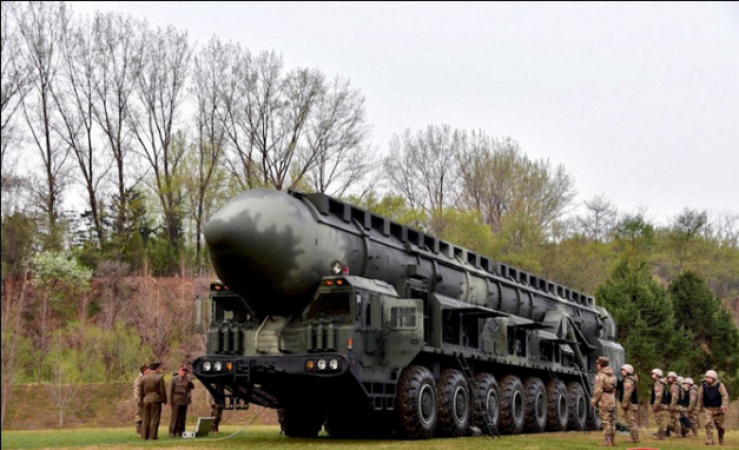
Seoul: State media reported that North Korea claimed to have tested the Hwasong-18, a new solid-fuel ICBM, on Friday in an effort to "radically promote" the nation's nuclear counterattack capability.
The test was directed by the leader Kim Jong Un, who issued a warning that it would cause enemies to "experience a clearer security crisis, and constantly strike extreme uneasiness and horror into them by taking fatal and offensive counter-actions until they abandon their senseless thinking and reckless acts."
North Korea has increased its weapons testing in recent months, criticising recent US-South Korean joint military drills as escalating tensions.
State-run media published images of Kim watching the launch with his wife, sister, and daughter, as well as the camouflage-netted missile being launched from a moving launcher.
Also Read: The Urus S from Lamborghini has been made available in India for a price of Rs. 4.18 crore.
"The development of the new-type ICBM Hwasongpho-18 will extensively reform the strategic deterrence components of the DPRK, radically promote the effectiveness of its nuclear counterattack posture, and bring about a change in the practicality of its offensive military strategy," KCNA said, using the initials of its official name.
In Korean, "pho" is the word for artillery.
According to analysts, this is the North's first attempt to use solid propellants in an intercontinental or intermediate-range ballistic missile.
Long regarded as a top objective for North Korea, the creation of a solid-fuel ICBM would enable the country to deploy its missiles more quickly in times of conflict.
The majority of the largest ballistic missiles in the nation use liquid fuel, necessitating the lengthy and risky process of propellant loading at the launch site.
Ankit Panda, a senior fellow at the US-based Carnegie Endowment for International Peace, said that solid-propellant missiles are an incredibly desirable capability for any country that operates large-scale, missile-based nuclear forces. In a time of crisis, these capabilities are much more responsive.
Also Read: Apple intends to achieve carbon neutrality by 2030
According to Panda, North Korea is likely to retain some liquid-fuel systems, which will make it harder for the US and its allies to plan ahead in the event of a conflict.
Solid-fuel missiles are more manageable, safer to operate, and require less logistical support than liquid-fueled ones, according to Vann Van Diepen, a former US government weapons expert who now works on the 38 North project. This makes them more evasive and resilient than liquid-fueled ones.
After testing a high-thrust solid-fuel engine in December, North Korea first unveiled what might be a new solid-fuel ICBM in a military parade in February.
According to analysts, the US could distinguish between a launch that used solid or liquid fuel by using early warning satellites that can spot differences in the infrared data produced by different kinds of missiles.
The most recent launch came days after Kim called for increasing war deterrence in a "more practical and offensive" way to counter what North Korea called American aggression.
Officials stated that the missile, which was launched from close to Pyongyang, travelled about 1,000 km (620 miles) before touching down in waters east of North Korea. North Korea claimed that there was no danger to its neighbours from the test.
The missile's maximum altitude, according to a South Korean military official, was lower than 6,000 km, which was the apogee of some of last year's record-breaking tests.
Also Read: This summer will see the worst financial collapse in history
Expert on missiles Chang Young-keun of Korea Aerospace University noted that the apogee appeared to have been lower than in earlier ICBM tests.
According to Kim Dong-yup, a professor at the University of North Korean Studies,
"North Korea could have chosen to focus on collecting data necessary to check its features at different stages rather than going full speed at the first launch." "North Korea will probably conduct some more tests," says the author, "as it was a test that did not demonstrate its normal flight pattern."